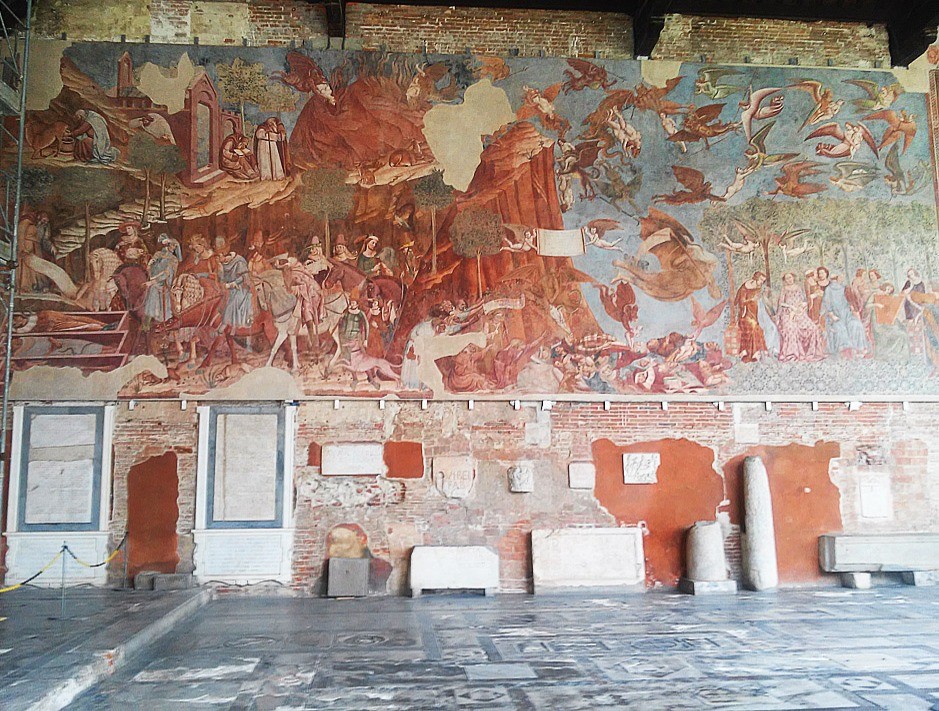Monumental Cemetery of Pisa
15-12-2020
 The Triumph of Death, the masterpiece created by Buonamico Buffalmacco between 1336 and 1341 returned to the monumental Camposanto of Pisa (also called the "Sistine Chapel of the Pisans") after over seventy years of absence: the spectacular fresco, seriously damaged during the bombings of the Second World War in 1944, was in fact torn shortly after to be subjected to restoration. The story of the restoration, however, lasted a long time, and only in 2018 the works were completed. The interventions of recent years, carried out by the technicians of the Opera della Primaziale, have been decisive. *(1)
The Triumph of Death, the masterpiece created by Buonamico Buffalmacco between 1336 and 1341 returned to the monumental Camposanto of Pisa (also called the "Sistine Chapel of the Pisans") after over seventy years of absence: the spectacular fresco, seriously damaged during the bombings of the Second World War in 1944, was in fact torn shortly after to be subjected to restoration. The story of the restoration, however, lasted a long time, and only in 2018 the works were completed. The interventions of recent years, carried out by the technicians of the Opera della Primaziale, have been decisive. *(1)Buonamico di Martino, called Buffalmacco (Florence around 1290 - 1340).
Florentine painter and joker and carefree character. It is still stylistically undefined, although the old writers, from Boccaccio to Vasari, praise him as one of Giotto's greatest contemporaries. He was a leading representative of Gothic painting in Tuscany in the first half of the 14th century. For a long time considered only a literary character, protagonist of amusing anecdotes and stories from Decameron onwards, the personality of Buffalmacco has only recently acquired a precise artistic physiognomy thanks to the research that attributed him to the frescoes of the Camposanto of Pisa, one of the most important masterpieces in the history of Italian art.
He formed just as Giotto monopolized the Florentine scene, but in Florence there was no place for him. He works in Arezzo, then in Pisa, a city that has fallen heavily after the glories of previous centuries. *(2)
In the Camposanto of Pisa Buffalmacco painted between 1336 and 1341 three grandiose frescoes with the Triumph of death, the Last Judgment and the Thebaid, celebrating the hermit and contemplative life as an antidote to death, inspired by the writings of the Dominican friar Domenico Cavalca. Already considered by critics to be a result of the shocking pestilence of 1348 and a figurative derivative of the Decameron (1350), the Triumph of the death of Pisa actually precedes both the epidemic and the mouth-watering tales. Buffalmacco expresses with unusual force the fear of death which in the fourteenth century is now nourished by a secular attachment to life and its pleasures. The painter dwells, as never before had any artist done, on the vision of the piled up corpses, on the tormented souls; it describes horribly decomposed bodies in front of which the living show dismay. His language presents analogies with that of Dante's Hell: it is powerfully realistic in its details, fraught with strong phrases, with trivial accents. With his "vulgar" as opposed to the "Latin" of the Giotteschi, Buffalmacco expands the limits of the Tuscan figurative style. * (3)
However, it is in the Triumph of death that Buonamico Buffalmacco reaches the top of his art, combining different autonomous narrative nuclei, functional to the representation of the theme, and creating a distressing narration that glues the observer to the wall to follow the story of Buffalmacco, which begins when a group of elegant young people walking in a wood discover the macabre presence of three corpses: from there opens the vision of death that comes from above to reap its victims, without sparing anyone and without making distinctions age, social status or wealth.
The entire Buffalmacco cycle is influenced by the works of the 14th-century scholar Domenico Cavalca, severe flogger of all social vanity, and they show surprising affinities with the contemporary creations of Dante and Boccaccio. The narrative liveliness and vividness of the colors, which characterized all the walls of the corridors, captured the attention of the spectator, guiding him in a continuous reflection on the theme of suffering. A spiritual journey that takes place in a closed space, confined behind the severe white marble curtain that overlooks Piazza del Duomo. * (4)
visit the monumental Cemetery and sleep near Pisa
MAIN SOURCES:
(1) - (4) https://www.finestresullarte.info/flash-news/1722n_pisa-trionfo-della-morte-buffalmacco-torna-al-camposanto.php
(2) https://it.wikipedia.org/wiki/Trionfo_della_Morte_(Buffalmacco)
(3) "Arte nel tempo" Pierluigi De Vecchi - Alda Cerchiari 1998 - Bompiani
